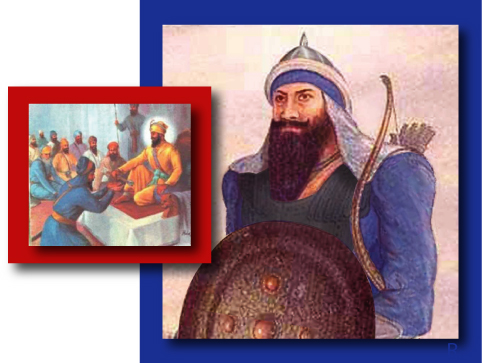Abd Us Samad Khan
Abd Us 'Samad Khan (d. 1737), governor of Lahore from 1713 to 1726, a descendant of the Naqashbandi saint `Abdulla Ahrar, a greatgrandson of Khwaja Baki of Baghdad, was born at Agra when his father, Khwaja `Abd ul-Karim Ansari, had come out with his family from Samarkand on a tour of India during the reign of Emperor Aurangzeb. When Samad Khan was two years old, his parents returned to Samarkand where he passed the early years of his life attaining the office of Shaikh ul Islam. Soon thereafter he came to India obtaining appointment at the court of Aurangzeb. He served for many years in the Deccan without attracting much notice.
Farrukh Siyar orders Samad Khan to wipe out Banda Singh Bahadur
However, when Farrukh Siyar came to the throne of Delhi, he appointed `Abd usSamad Khan governor of Lahore in February 1713 charging him with the annihilation of the Sikh leader, Banda Singh Bahadur, who had raised a revolt in the Punjab. `Abd usSamad Khan`s son, Zakariya Khan, was sent to Jammu as faujdar to render assistance to his father. `Abd usSamad Khan`s troops succeeded in driving Banda Singh and his Sikhs out of their strongholds in the plains Sadhaura and Lohgarh into the hills.
As Banda Singh descended from his mountain retreat in February 1715, Samad Khan assembled an army of Mughals, Pathans, Bundela Rajputs and the Rajputs of Katoch and Jasrota and moved northwards to attack Banda Singh. According to Akhbari DarbariMu`alla, `Abd usSamad Khan marched from Lahore at the head of twelve thousand sowars and an equal number of footsoldiers, besides a big topkhana (artillery), and closed in upon Banda Singh as he was putting up his defencive fortifications in a village, near Batala.
Khan's artillery barrages forced Banda Singh to come into the open field, where he made a determined stand fighting fiercely. But overwhelmed by a force vastly superior in strength and resources, he escaped northwards and took shelter in the haveli or fortress of one Duni Chand at the village of Gurdas Nangal, about 6 km to the west of Gurdaspur. `Abd usSamad Khan threw such a tight cordon around the haveli that it was said, "not a blade of grass or a grain of corn could find its way in."
Weakened by starvation the Sikh defences failed
For eight months the garrison resisted the siege under gruesome conditions. The royal troops at last broke through and captured Banda Singh and his famishing Sikhs (17 December 1715). Under the orders of Samad Khan over two hundred of the prisoners were executed. The rest, including Banda Singh and his family, were put in chains and taken to Lahore, thence to Delhi. In 1726, Samad Khan was transferred to Multan, his son, Zakariya Khan, replacing him as governor of Lahore. `Abd usSamad Khan died on 26 July 1737. For more than two decades he had enjoyed the confidence of the Delhi emperors and received from them titles such as DalerJang (Brave in Battle) and Saif udDaula (Sword of the State), with a rank of seven thousand (soldiers).
In the Mughal army one's rank, salary and position when in court with the Emperor were based on numbers of soldiers controlled. It was when Shivaji, after paying a nazar of 1500 golden mohurs to Aurangzeb, only to find himself relegated to a position behind men of lesser rank that he pitched one of the few 'scenes' recorded in any of the Great Mughal's presense.
References
1. Irvine, W., Later Mughals. London, 1922
2. Nijjar, B.S., Panjab under the Later Mughals. Jalandhar, 1972
3. Gian Singh, Giani, Twarikh Guru Khalsa [Reprint]. Patiala, 1970
4. Bhagat Singh, trans. and ed., AJchbar-i-Darbar-i-Mu`alla. Patiala, 1984
5. Harbans Singh, The Heritage of the Sikhs. Delhi, 1987

